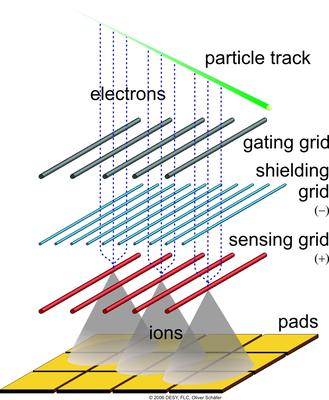Gas Amplification with Micro Pattern Gas Detectors
Amplification with Proportional Wires
Traditionally, multiwire proportional chambers have been used in TPCs as standard device for gas amplification. In this technique, tense parallel wires are mounted in front of the pad plane. These wires are on potentials, such that the arriving electrons are accelerated in their field, gaining an energy to the magnitude where ionization happens. To "flatten" the field towards the chamber, an additional layer of wires are mounted in this direction to minimize the influence of the sense and field wires behind.
The produced ions drift back into the TPC volume and induce a (very broad) signal on the pad plane behind the wires. So the electron signal is measured at the wires and (to improve the resolution) also the induced ion signal at a pad plane.
Since ions in the TPC volume should be avoided, a third layer of wires (which is called the gate) is necessary. When the gate is open the gating wires are at the same potential as the field in this region. In this state, drifting electrons (and ions) pass this grid without disturbance. To close the grid (which is the normal state) and collect the ions, the potential of neighboring wires is set alternating to ± 50-100 V. At this setting, the drifting ions and electrons are collected on the wires.
Some drawbacks of this technique (see below) have led to the development of new amplification structures, the so-called micro-pattern gas detectors (MPGDs).
Drawbacks of Proportional Wires
With proportional wires, the signal is very broad and the distance between two wires is mechanically limited. This makes it difficult to separate two nearby tracks and set limits to the possible rφ and time resolution.
A second disadvantage is the high material budget of the support structures that hold the wires. To provide a perfectly parallel alignment the wires have to be mounted under very high tension. This demands for a very solid mounting system with a high material budget.
Third, the gating is problematic in experiments with a high event rate, where the time between two events is too short for the gating and measurement cycle. If the events do overlap, which means the drift needs longer than the time between two events, gating becomes impossible.
In the case of the ILC all these three problems are realized. A good two-track separation and precise time resolution is needed to achieve the physics goal of the project. To be able to make a very precise energy measurement in the calorimeter, the material budget is very limited. Furthermore, the collision rate is so high that the gating with a grid would not work anymore. Therefore a new amplification techniques are needed. These are called Micro Pattern Gas Detectors (MPGDs). Two different technologies of micro-pattern devices are under investigation for their use in a TPC at the ILC: the Micro Mesh Gaseous Detectors (MicroMEGAS) and Gas Electron Multipliers (GEMs).


